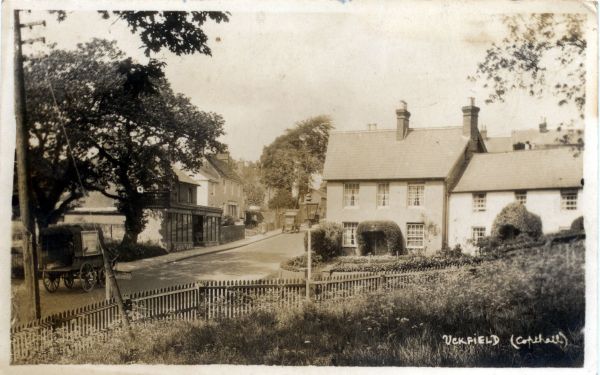George Bingham Towner

Copthall, Uckfield
Photographer, Uckfield. Towner was born at Uckfield early in 1881, and was the son of Henry Bingham Towner and Ann or Anne Towner, formerly Sandels. Henry (whose mother's maiden name was Bingham) had been born on December 24, 1848 at Uckfield, and worked first as a rural messenger for the Post Office and then (by 1901) as a rural postman. Ann, who had been born in 1848 at Isfield, was the daughter of a nurseryman. She and Henry married in 1870 and had 6 children in addition to George: Alice Towner (1871-1945), Herbert Henry Towner (1873-1976), Ann Towner (1876-1973), Charles Clifford Towner (1878-1935), Emily Towner (1884-1965) and Elizabeth Mary (Bessie) Towner (1887-1980). The family lived on the southern edge of Uckfield at Ridgewood, which was then a small hamlet. Ann died in 1925 and her husband in 1934.
The Uckfield and District Preservation Society reproduce a photograph of Henry Towner in his postman's uniform in their book Around Uckfield (1997, Chalford Publishing, Gloucester, p. 101) and comment that in his 41 years service as a postman he walked 205,000 miles on his round between Uckfield and Isfield via Little Horsted for a wage of 12 shillings (60p) a week. A friendly MFH gave him a hunting horn so that he could warn isolated farms of his approach.
Writing in the Summer 2000 edition of Hindsight, the journal of the Uckfield & District Preservation Society ("The Bingham Towner family", volume 6, 81-84), Carolyn Baird recalls that George Towner, her paternal grandfather, began his working life aged 15 as a Post Office telegraph boy. A photograph of George in his uniform is reproduced in Around Uckfield (p. 58). In his spare time, he became a pupil of Uckfield's leading photographer, John Frisby, and in June 1903 he photographed the bridge over the river Uck in the centre of the town after it had collapsed under the weight of a passing traction engine, severing the gas and water mains. His picture was reproduced as a printed postcard, but he was probably not the actual publisher.
1906 was an eventful year for Towner. He converted to Roman Catholicism, and married Cecilia Harriet Webb at Bath. The couple settled at 1 Harcourt Road, on the corner of Framfield Road, where he opened his own portrait studio (the Harcourt Studio). He still worked as a postman, however, and photography was just a sideline. In 1909 his first son, Henry Andrew Bingham Towner, was born, to be followed by Francis John Towner in 1918.
According to Carolyn Baird, Towner was excused military service during the war because of a leg injury, but was made local war photographer. A card of his survives showing troops waiting for a train at Uckfield Railway Station. In the 1920s he managed to obtain enough work as a wedding and portrait photographer to retire as a postman. In 1926 he closed his Harcourt Road studio and bought Number 222 in Uckfield High Street, where he opened a larger studio and also a shop. In the Second World War a bomb destroyed many of his negatives, but he and his family escaped uninjured.
Towner handed over his High Street studio and shop to his son Francis in 1947, and retired to the Garden House in Maresfield Park. Cecilia died in 1959, but Towner was able to busy himself in his garden and conservatory, tending his vines, bees and guinea fowl. He died aged 94 in 1975.
Towner began publishing real photographic cards before the First World War, but apparently in small numbers as the cards are hard to find today. Amongst the earliest known are a pair of sepia tinted cards of a tree splintered by lightning at Hundredhouse Farm, Framfield in July 1913. The photographs on his early cards usually have no border, the captions are written in tiny irregular capitals and on one card two letters are reversed, which suggests that the captions were written mirror-image.
In the 1920s Towner produced greater numbers of cards, concentrating apparently on villages around Uckfield. A black and white real photographic card of "East Hoathly War Memorial, unveiled October 16th 1921" with a white border is labelled "G.B. Towner, Harcourt Studio, Uckfield". Another card shows the unveiling of Fletching War Memorial on November 13, 1921. A card of the interior of Framfield Memorial Hall is likely to have been published to mark the opening of the Hall in January 1924.
Towner also sold black and white real photographic cards of High Hurstwood that were printed on photographic card manufactured by Thomas Illingworth & Co. of London. These are labelled on the back "Bingham Towner, 222 High Street, Uckfield" and so must have been produced after his move from the Harcourt Studio in 1926. One example has been found that was posted in 1928. The captions on these cards are written in block capitals in a rather variable manner. The most distinctive feature is that "D"s have leftward pointing tails. One street scene shows a motorcycle with sidecar parked by the verge, and also a bicycle. Which one, if any, Towner used as transport is not known.
Towner cards of Uckfield are scarce, but include pictures of the 1924 town carnival. A black and white view of Rocks Road on the edge of Uckfield must date from 1926 or later as it is labelled on the back "Bingham Towner, 222 High Street, Uckfield".
A blank-backed real photographic card of St. Margaret's Church at Buxted was issued in June 1951 to mark the 700th anniversary of the church (see Gallery). The photograph is credited to "Bingham Towner, Uckfield", and may indeed be the Uckfield photographer's work. However, an alternative explanation is that his son, Henry Bingham Towner (1909-1991), was responsible. Henry had trained as an architect and started a practice in Uckfield in 1938, specialising in church construction and renovation. He supervised the restoration of Buxted Church in 1950.
To directory of publishersTo gallery
Design: Lucid Design
© www.sussexpostcards.info
